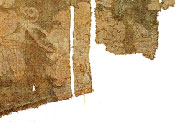 |
 |
||||||||||||||||||||||||||||||||||||||
 |
|||||||||||||||||||||||||||||||||||||||
 |
|||||||||||||||||||||||||||||||||||||||
| CHAPTER 7 | |||||||||||||||||||||||||||||||||||||||
 |
|||||||||||||||||||||||||||||||||||||||
| 0701 gPeach blossoms and thrush 0701 gAttributed to Zhu Kerou 0701 g(mid-12th century) |
|||||||||||||||||||||||||||||||||||||||
| Silk tapestry Dimension: warp 23.1cm; gf dgdfggh weft 22.6cm The National Palace Museum, Taibei |
|||||||||||||||||||||||||||||||||||||||
 |
|||||||||||||||||||||||||||||||||||||||
| THE BOOK | |||||||||||||||||||||||||||||||||||||||
| AUTHOR | |||||||||||||||||||||||||||||||||||||||
| CONTENTS | |||||||||||||||||||||||||||||||||||||||
| ORDER | |||||||||||||||||||||||||||||||||||||||
| Since kesi allows free changing in colour during the weaving process, it is suitable for producing images in the style of paintings. With the promotion of the Song emperor Huizong and the rise of the academy school of painting, it became fashionable for kesi weavers to produce works using bird and flower subjects. Some of them were preserved through the dynasties, including works attributed to Zhu Kerou and Shen Zifan, and they made a tremendous influence on kesi works of art in the later periods. Kesi items for daily use also employed similar subjects, but their appearance resemble woven textiles more closely. One such example is the kesi birds and flowers on purple ground. The most famous of the extant works is a set of album leaves by Zhu Kerou, born in Songjiang, Jiangsu, and active during the reign of Gaozong (1127-1161AD). Subjects include peony, camellia and peach blossoms with birds or butterflies. The wefts are extremely fine, and tonal gradations are achieved in such even manner that there are nearly no junctures discernible. Details such as the pollen on the petal and young shoots are rendered with a sense of naturalism, even surpassing the medium of ink and paper. Note: Fong & Watt 1996; Liaoning 1982 |
|||||||||||||||||||||||||||||||||||||||
| CONTACT | |||||||||||||||||||||||||||||||||||||||
| LINKS | |||||||||||||||||||||||||||||||||||||||
|
|
||||||||||||||||||||||||||||||||||||||